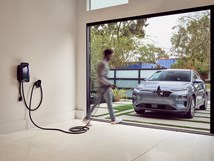VW Aero Car from the 1980s
Yes, it is highly aerodynamic. And for a car with 177 hp, fast. But not exactly the stuff of daily driving.
#aluminum #hybrid
Volkswagen engineers back in the 1980s wanted to see the effects of aero and mass on vehicle performance. Especially aero. Just look at this, the Aerodynamic Research Volkswagen (ARVW):

This is the ARVW, a study in aerodynamics by Volkswagen. (Images: VW)
The vehicle was built in 1980. It has a single seat. It is 33 inches tall and 43.3 inches wide.
There is an aluminum frame below the fiberglass and carbon-fiber composite skin.
Located behind the driver is a 2.4-liter turbocharged inline six that produces 177 hp. A chain drive powers the rear wheels.

One wonders: would a chiropractor be part of the development team?
There is a water tank that provided the fluid injected into the turbocharger intake. The primary engine cooling vent is in the nose and the air was expelled over the top of the vehicle.
The wheels are covered. The underbody is smooth. And there are moveable fins to help provide stability at speed.
The coefficient of drag of the ARVW is just 0.15.
A team of VW engineers and a professional driver went to the Nardo test track in Italy. It was October 1980. The car hit 221 mph during its first hour on the track.
They were able to get it up to a record-setting 225 mph.
The design of the ARVW was influential for that of the VW XL1, a limited-run production car (yes, a real car: I actually drove one in Wolfsburg, perhaps the one in this picture) that was rated at 261 mpg.

The very limited VW XL1 high-mileage hybrid vehicle of 2013.
Although the ARVW is certainly quick, it probably isn’t particularly comfortable.
RELATED CONTENT
-
McLaren Meets LEGO
There is a growing concern that young people are becoming increasingly disinterested in automobiles, that they’ll avail themselves of Lyft or Uber when they reach the Age of Visiting the DMV, not of a driver’s license and a beater.
-
Increasing Use of Structural Adhesives in Automotive
Can you glue a car together? Frank Billotto of DuPont Transportation & Industrial discusses the major role structural adhesives can play in vehicle assembly.
-
Light Rider
When you think of the forthcoming LA Auto Show and Los Angeles in general, you may think of (1) very expensive, very large vehicles being piloted by very egotistical stars and (2) very jammed freeways full of the aforementioned, as well as numerous other vehicles of a less ostentatious variety.


.jpg;width=70;height=70;mode=crop)






